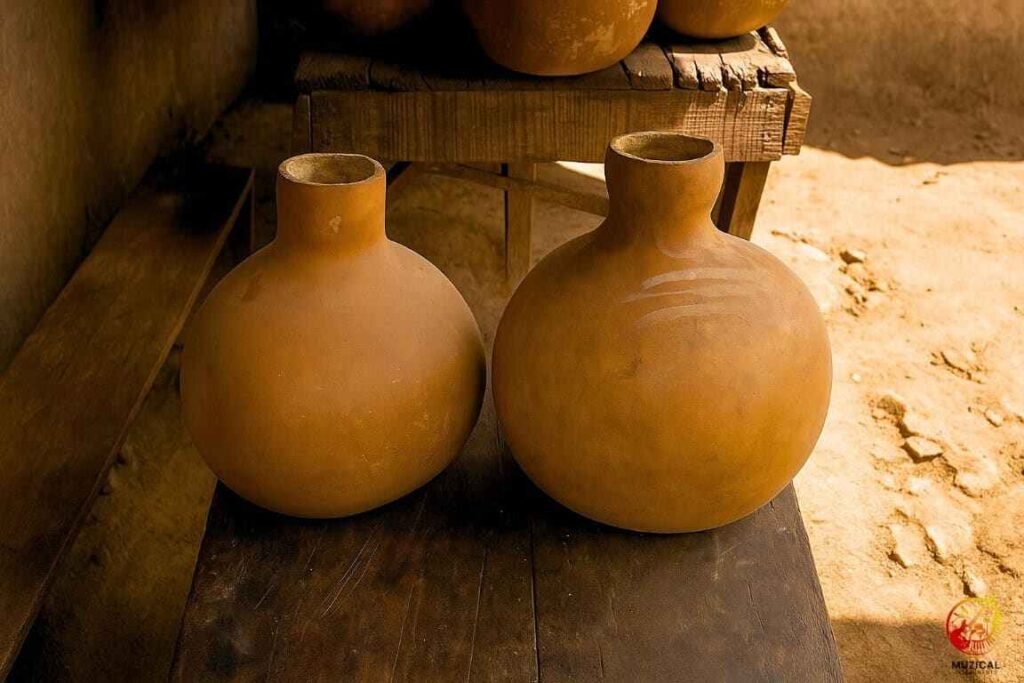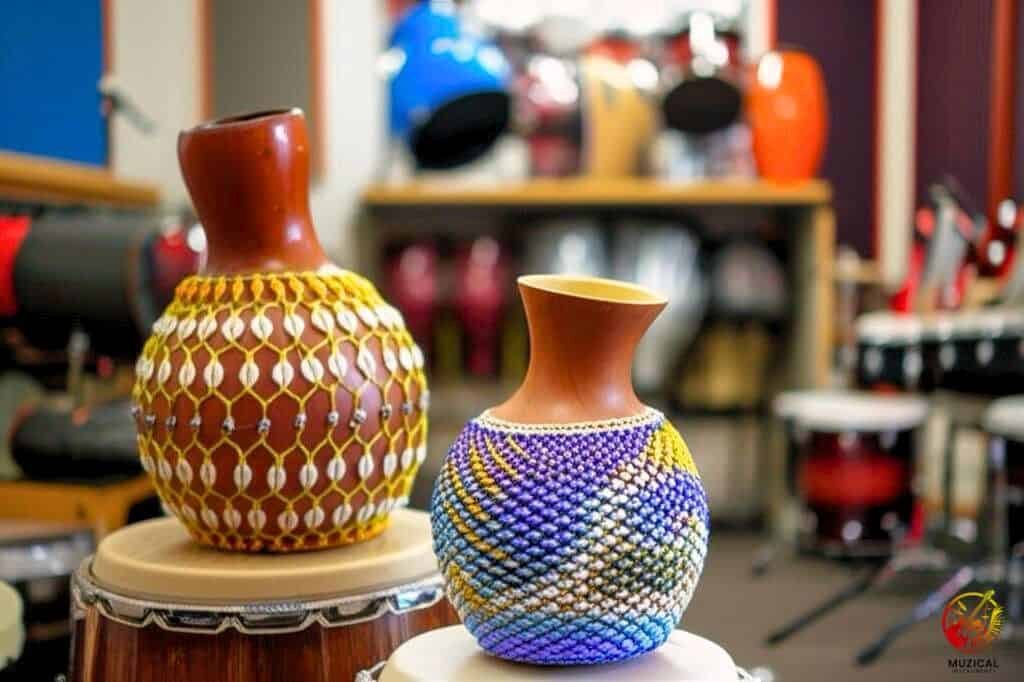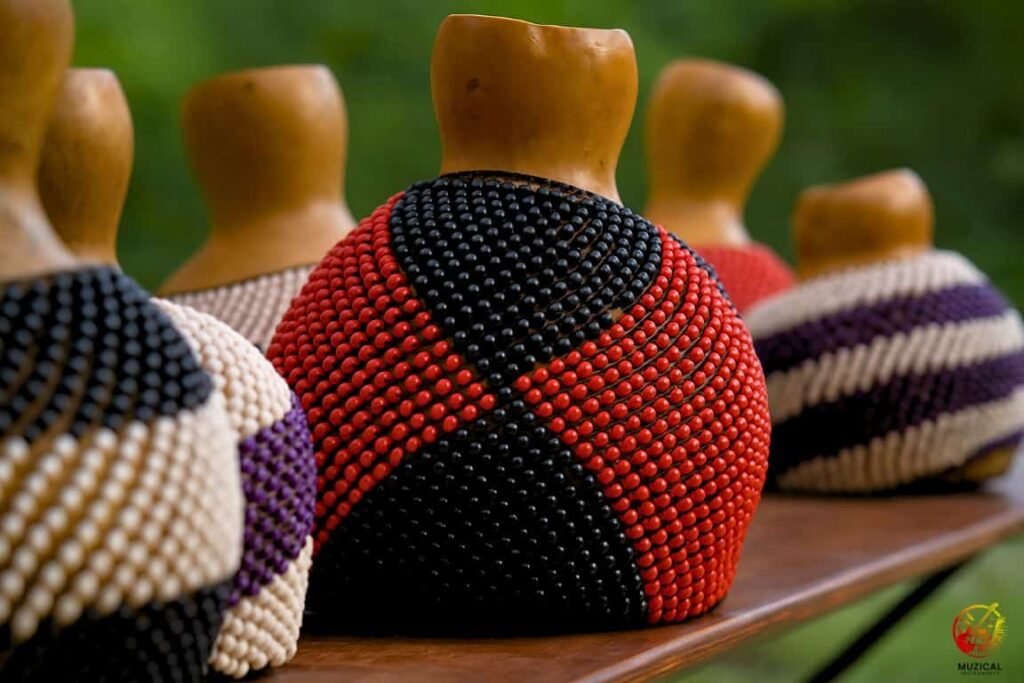Why Is Shekere Made from Gourd?
The shekere’s unique, rattling sound adds a special energy to music that’s hard to miss. Have you ever asked yourself why is shekere made from gourd? It’s not just because of tradition. This choice is a perfect mix of nature, science, and culture.
Gourds are naturally hollow, lightweight, and durable when dried. That hollow body acts like a resonating chamber, when beads strike the gourd, the sound echoes with warmth and gives the shekere its classic voice, a sound loved in West African music and around the world.
In this guide, you’ll learn about the gourd’s special sound qualities, its deep cultural roots, and how this traditional instrument is made.
We’ll explore why this simple dried fruit is the heart and soul of the shekere.
What Makes the Gourd So Perfect for a Shekere?

So, what’s the secret behind the gourd? The special features of the Lagenaria siceraria, or bottle gourd, make it the ideal material. It’s a combination of several key things that work together perfectly.
Resonance
When a gourd dries, its shell gets hard and hollow, turning it into a natural amplifier. Think of it like the body of an acoustic guitar. The gourd’s shell vibrates when the beads hit it, making the sound louder and warmer. The empty space inside lets the sound bounce around, giving it a full, rich tone. This is a big reason why is shekere made from gourd, it naturally makes music sound good.
Sound Variation
One of the coolest things about gourds is that no two are exactly the same. Each one has a slightly different shape, size, and thickness. This means every handmade shekere has its own unique voice. A big, thick gourd might make a deep, low sound, while a smaller one could be high and sharp. This natural variety makes each instrument special, which is something you don’t get from a factory made instrument.
Durability and Weight
A shekere needs to be both strong and light. A dried gourd is surprisingly tough and can handle being played for a long time. It’s also very light, so musicians can hold it and play complex rhythms without getting tired. This perfect balance of strength and low weight is a natural gift of the gourd.
Natural Material
Using a gourd is also about using what the earth provides. Gourds were one of the first plants people grew, used for everything from bowls to tools. Making an instrument from a gourd connects the music directly to the land. It’s a sustainable, biodegradable material, which adds to the shekere’s earthy feel and sound.
Adaptability
Gourds come in all shapes and sizes. This variety allows artisans to create a whole family of shekeres, from small ones with a high pitch to huge ones that produce a deep bass rhythm. The gourd’s smooth, hard surface is also perfect for tying the net of beads around it, making sure it fits just right for a crisp, clear sound.
How Does the Gourd’s History Shape the Shekere’s Identity?

To fully understand why is shekere made from gourd? you have to look at its history in West Africa, especially with the Yoruba people of Nigeria and Benin. Gourds, also known as the calabash, were a part of everyday life. They were used as containers for food and water, so they were always around.
Using a common object like a gourd to make music was a natural step. It connected the instrument to the community, the harvest, and daily traditions. The shekere, or àgbẹ in the Yoruba language, became a key part of ceremonies, festivals, and storytelling. Its sound was seen as a way to connect with ancestors and spirits.
When West Africans were forcibly brought to the Americas, they brought their traditions with them. The shekere took root in places like Cuba and Brazil, becoming a powerful symbol of their culture and strength. The gourd itself represents this deep history and resilience, making the instrument much more than just a noisemaker.
Why Is Shekere Made From Gourd and How Is It Crafted?
Turning a simple gourd into a musical instrument is a true art form. This traditional craft takes time and skill. The process shows just how important the right gourd is. Here’s a simple breakdown of how it’s done.
| Step | Description | What the Artisan Focuses On |
|---|---|---|
| 1. Choosing a Gourd | The maker picks a ripe gourd with the right shape and a hard shell. A good, even shape is a great start. | Finding a gourd that looks like it will have a great sound and last a long time. They often tap it to hear its raw tone. |
| 2. Drying | The gourd is left to dry for many months. This is a slow process where all the moisture inside evaporates, making the shell hard. | Being patient. If the gourd dries too fast, it will crack. It needs a dry, airy place to cure properly. |
| 3. Cleaning | The top of the gourd is cut open, and all the dried pulp and seeds are scraped out. The outside skin is cleaned off to show the smooth shell. | Making sure the inside is completely empty and clean. This creates the hollow chamber needed for a big, resonant sound. |
| 4. Finishing | The gourd is often polished with oil or a light varnish. This makes it look nice and protects it from moisture. | Protecting the gourd so it will last for years. This final touch can also help fine-tune the instrument’s sound. |
| 5. Netting and Beading | A net is woven from string, and beads, seeds, or shells are tied onto it. The net is then fitted tightly around the gourd. | Getting the net tension just right. A tight net gives a crisp, sharp rattle, which is the classic shekere sound. |
Pro Tip: The type of beads used makes a huge difference! Hard plastic beads create a loud, sharp sound, while softer seeds or cowrie shells produce a more traditional, earthy rattle.
Are Modern Shekeres Better Than Traditional Gourds?

Today, you can find shekeres made from fiberglass or plastic. This brings up a good question: are they a better choice? It really depends on what you need as a musician. This is another way to think about why is shekere made from gourd and what makes it different.
Fiberglass shekeres are very loud and durable. If you’re playing in a band with electric guitars and drums, a fiberglass shekere can be heard easily. It also won’t crack if you accidentally drop it, making it great for touring.
But, what you gain in volume, you lose in character. A shekere made from a gourd has a warmth and richness that synthetics can’t copy. The sound of a fiberglass shekere is often described as brighter and more one dimensional. For recording music or playing in an acoustic setting, most musicians prefer the natural, complex sound of a real gourd.
| Feature | Gourd Shekere | Fiberglass/Plastic Shekere |
|---|---|---|
| Sound | Warm, earthy, and complex. Each one sounds unique. | Loud, sharp, and bright. Very consistent sound. |
| Durability | Can crack if dropped. Needs care. | Very tough and hard to break. Great for travel. |
| Volume | Good for acoustic music and recording. | Very loud. Cuts through a mix of loud instruments. |
| Feel | Natural, organic, and traditional. | Modern and manufactured. |
What’s the Difference Between a Shekere, Maracas, and a Cabasa?
It’s easy to mix up different shakers, but the shekere is unique. Knowing the difference helps you appreciate why is shekere made from gourd?
The main difference is where the beads are:
- Shekere: The beads are on a net on the outside of the gourd. This lets you create sound by shaking it or by tapping the gourd itself for different tones.
- Maracas: The beads or seeds are inside a hollow shell. The sound comes from them hitting the inner walls.
- Cabasa: This instrument has metal chains wrapped around a metal cylinder. You twist it to make a scraping, hissing sound.
So, a shekere is an external rattle, maracas are internal rattles, and a cabasa uses friction. This basic design difference is key to how each instrument is played.
Final Thoughts
In the end, the answer to “Why is shekere made from gourd?” is simple: it’s the perfect material for the job. The gourd provides natural resonance, a unique voice, and a lightweight yet strong body.
Beyond the sound, it carries centuries of West African culture, history, and tradition within its hollow shell.
While modern fiberglass versions have their place, they can’t replace the warm, earthy soul of a traditional instrument.
The gourd is not just a part of the shekere; it is the shekere.
The next time you hear one, listen for the rich sound that can only come from this amazing gift of nature.
FAQ: Why Is Shekere Made from Gourd?
1. How does the shape of the gourd affect the sound of the shekere?
The shape and size of the gourd greatly influence a shekere’s tone. Larger, rounder gourds generate deeper, richer bass tones. Smaller or elongated gourds produce lighter, higher pitched sounds. The curves guide how air vibrates inside, subtly altering the character of the rattle.
2. What types of gourds are used to make shekere?
Traditionally, vine grown gourds, also known as calabash or bottle gourds, are used. They’re picked once fully mature, dried for months, and then cleaned and scrubbed before being fitted with beaded nets.
3. How is a shekere constructed from a gourd?
Construction involves these key steps:
Selecting and drying a mature gourd for several months
Removing the pulp and seeds
Scrubbing the shell until smooth
Weaving a net of beads (or seeds, shells) tightly around the outside, this creates the rattling “skirt”
This process prepares the gourd to vibrate and resonate clearly.
4. Can shekeres be made from materials other than gourds?
Yes, while traditionalists favor the natural gourd for its organic tone, modern makers sometimes use fiberglass, plastic containers, or other synthetic shells for durability or consistent sound. But many musicians still choose gourds for their unique, earthy resonance.
5. How do you play a gourd shekere?
You can play shekere by shaking it, slapping it against your hand, or using a twist motion that keeps the beads stationary while the gourd moves. Each technique brings a slightly different sound, shaking gives a steady rhythm, slaps add sharp accents, twists create rhythmic friction.
6. Where did the shekere originate, and how did gourds become central to its design?
The shekere originated in Yorubaland (present day Nigeria, Benin, Togo). Communities used what grew around them, vine gourds were abundant, sturdy, and easy to hollow. These gourds became natural choices for creating resonant, handcrafted instruments long before modern alternatives existed.
